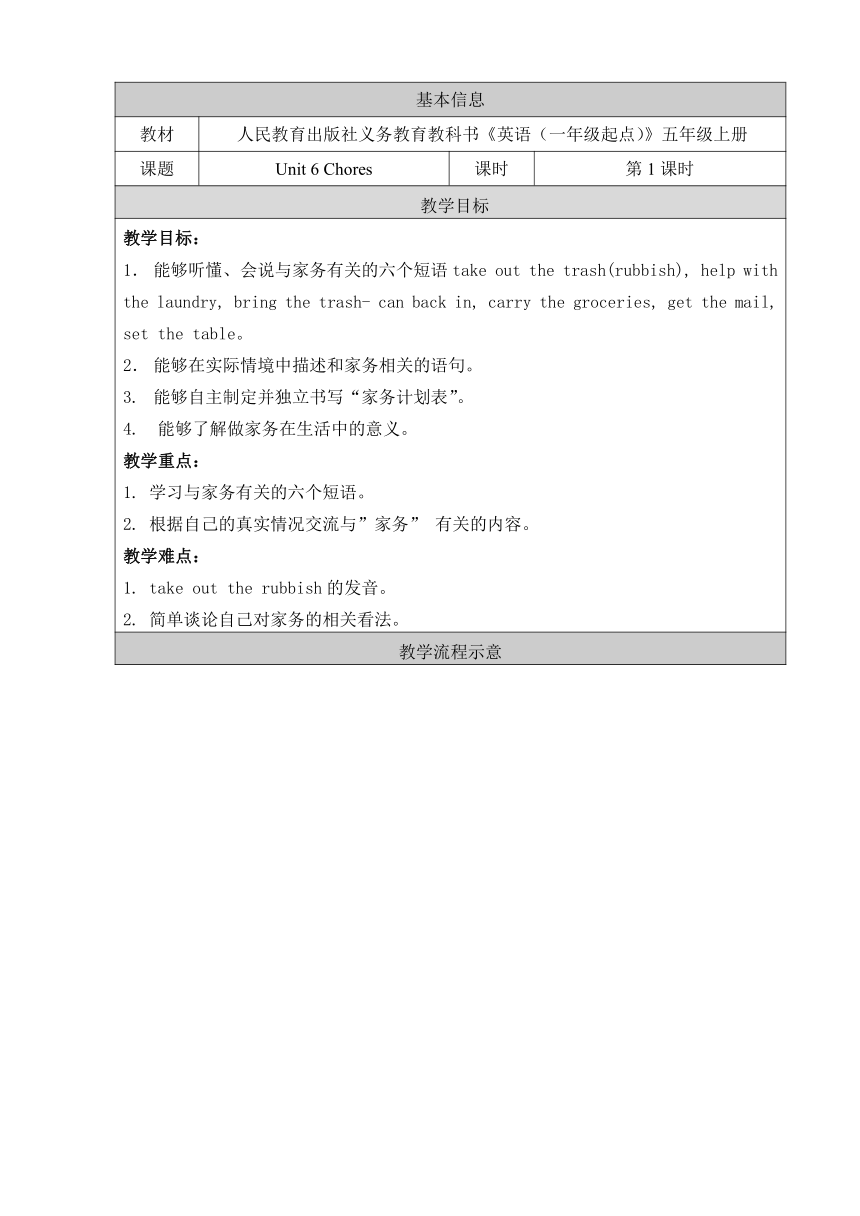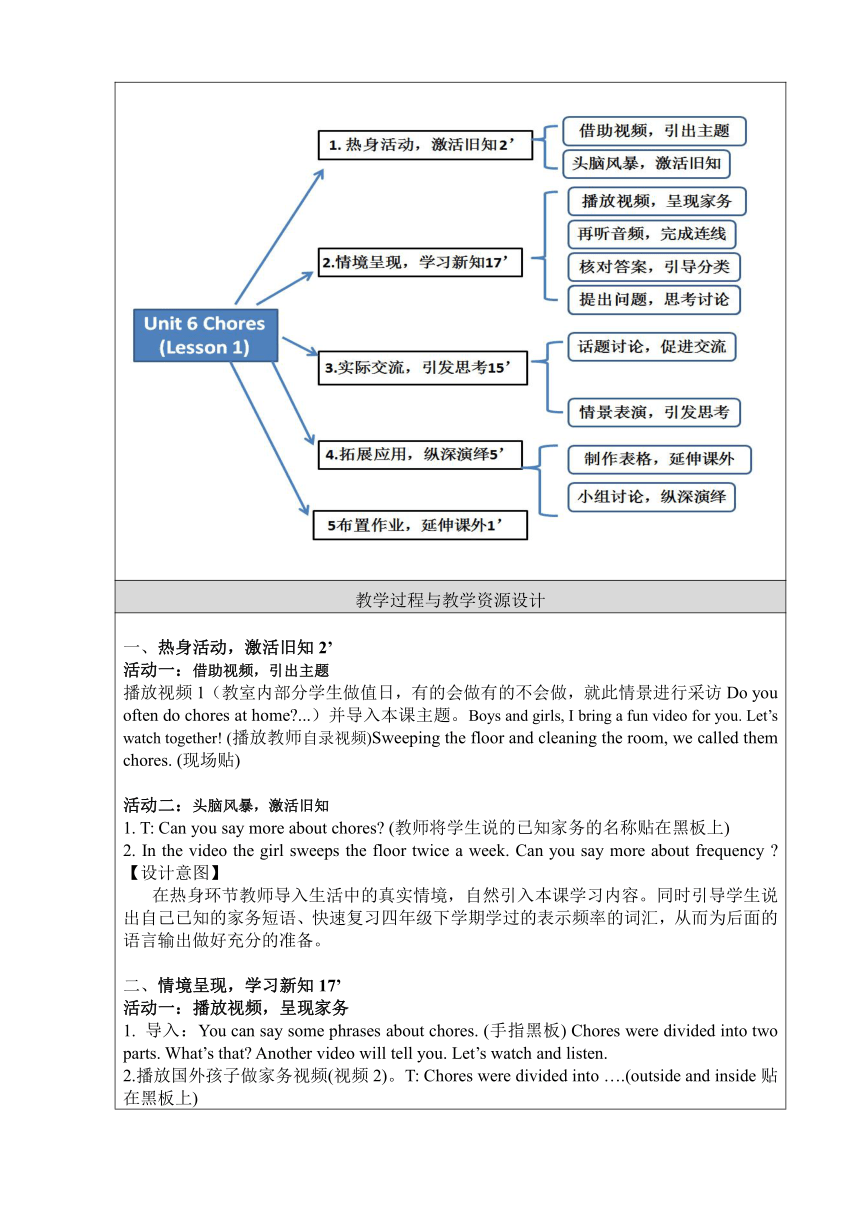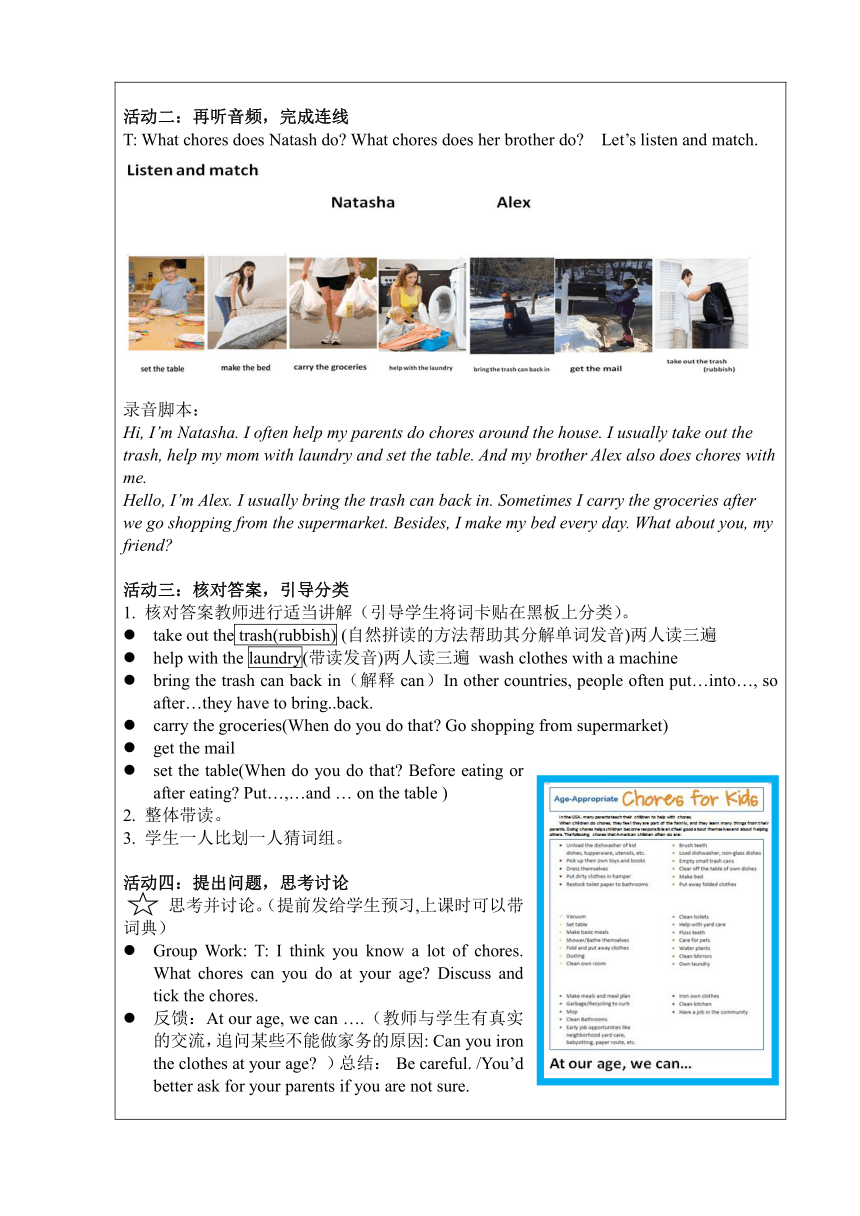Unit6 Chores Lesson1 表格式教案
文档属性
| 名称 | Unit6 Chores Lesson1 表格式教案 |  | |
| 格式 | doc | ||
| 文件大小 | 9.1MB | ||
| 资源类型 | 教案 | ||
| 版本资源 | 人教(新起点) | ||
| 科目 | 英语 | ||
| 更新时间 | 2022-06-12 15:20:23 | ||
图片预览



文档简介
基本信息
教材 人民教育出版社义务教育教科书《英语(一年级起点)》五年级上册
课题 Unit 6 Chores 课时 第1课时
教学目标
教学目标:1. 能够听懂、会说与家务有关的六个短语take out the trash(rubbish), help with the laundry, bring the trash- can back in, carry the groceries, get the mail, set the table。2. 能够在实际情境中描述和家务相关的语句。3. 能够自主制定并独立书写“家务计划表”。4. 能够了解做家务在生活中的意义。教学重点:1. 学习与家务有关的六个短语。2. 根据自己的真实情况交流与”家务” 有关的内容。教学难点:1. take out the rubbish的发音。2. 简单谈论自己对家务的相关看法。
教学流程示意
教学过程与教学资源设计
一、热身活动,激活旧知2’活动一:借助视频,引出主题播放视频1(教室内部分学生做值日,有的会做有的不会做,就此情景进行采访Do you often do chores at home ...)并导入本课主题。Boys and girls, I bring a fun video for you. Let’s watch together! (播放教师自录视频)Sweeping the floor and cleaning the room, we called them chores. (现场贴)活动二:头脑风暴,激活旧知1. T: Can you say more about chores (教师将学生说的已知家务的名称贴在黑板上)2. In the video the girl sweeps the floor twice a week. Can you say more about frequency 【设计意图】在热身环节教师导入生活中的真实情境,自然引入本课学习内容。同时引导学生说出自己已知的家务短语、快速复习四年级下学期学过的表示频率的词汇,从而为后面的语言输出做好充分的准备。二、情境呈现,学习新知17’活动一:播放视频,呈现家务1. 导入:You can say some phrases about chores. (手指黑板) Chores were divided into two parts. What’s that Another video will tell you. Let’s watch and listen.2.播放国外孩子做家务视频(视频2)。T: Chores were divided into ….(outside and inside贴在黑板上)活动二:再听音频,完成连线T: What chores does Natash do What chores does her brother do Let’s listen and match. 录音脚本:Hi, I’m Natasha. I often help my parents do chores around the house. I usually take out the trash, help my mom with laundry and set the table. And my brother Alex also does chores with me.Hello, I’m Alex. I usually bring the trash can back in. Sometimes I carry the groceries after we go shopping from the supermarket. Besides, I make my bed every day. What about you, my friend 活动三:核对答案,引导分类1. 核对答案教师进行适当讲解(引导学生将词卡贴在黑板上分类)。take out the trash(rubbish) (自然拼读的方法帮助其分解单词发音)两人读三遍help with the laundry(带读发音)两人读三遍 wash clothes with a machinebring the trash can back in(解释can)In other countries, people often put…into…, so after…they have to bring..back.carry the groceries(When do you do that Go shopping from supermarket)get the mailset the table(When do you do that Before eating or after eating Put…,…and … on the table )2. 整体带读。3. 学生一人比划一人猜词组。活动四:提出问题,思考讨论思考并讨论。(提前发给学生预习,上课时可以带词典)Group Work: T: I think you know a lot of chores. What chores can you do at your age Discuss and tick the chores.反馈:At our age, we can ….(教师与学生有真实的交流,追问某些不能做家务的原因: Can you iron the clothes at your age )总结: Be careful. /You’d better ask for your parents if you are not sure.【设计意图】引发学生思考:哪些是你这个年龄能做的家务?---即“能做什么?”三、实际交流,引发思考15’活动一:话题讨论,促进交流1.教师呈现已学句型:I believe you can do these chores. But actually do you often help your parents do chores at home (贴句子)2. 教师通过与几名同学的对话将左侧板书补充完整。(最后要与学生有真实的交流, 教师可以追问Do you like to do that Why or why not )3. 右侧板书:No, I don’t. 教师追问Why don’t you help your parents do chores S1: I have to do lots of homework every day. T: What do you want to say to … (两人讨论后反馈--easy chores/ do homework quickly)之后教师继续追问: What chores do you want to do at home I want to…教师还可以继续追问:Why do you choose … 4. 教师呈现另一种不做家务的原因:There is a sound from a mother. Let’s listen! 播放音频后:What do you want to say to the mother (两人讨论后反馈) (member of the family, share some chores / These life skills will make us independent, learn some life skills. )5. 两人交流句型。(根据自己真实情况回答)【设计意图】在交流句型操练新短语时教师结合在前测时发现的真实情况对本单元句型进行了适当的补充,这样学生可以比较真实的表达自己的实际情况。活动二:情景表演,引发思考小组思考、讨论并情景表演:When you grow up, you will be a mother or father. Would you ask your kids to do chores 长大后你当父母,你会让你的孩子做家务吗?Why or why not Discuss and make up a dialogue学生两人讨论后表演出来,教师总结几点Chores Teach Responsibility(责任) –you are the member of family/ share…Chores Teach Skills(技能)--learn some life skillChores mean accomplishment(成就) –Helping your parents means you are growing up. You are not a child. 【设计意图】本环节教师对学生的思维品质进行了有意识的训练,当你长大成为父母后,你会让你的孩子做家务吗?为什么?”引导学生在趣味情景表演中思考家务后面的深层次含义。---即“为什么要做家务?”四、拓展应用,纵深演绎5’活动一:制作表格,延伸课外导入T: We know chores are very necessary, so we have to do chores as more as possible, but as a student, you are so busy. How do you make a plan for it Look! Making a plan about chores can help you!学生自己完成反馈并总结【设计意图】本环节是对今天学习内容的升华。在学习了有关家务活动的短语、思考了做家务的相关问题后,带领学生制作“家务表格”并将学习内容延伸到课外,即落实在日常生活中--我们应该怎么做家务。活动二:小组讨论,纵深演绎T: T This class we talk about chores. What do you think of doing chores Boring or interesting ...Chores are fun! What can we do to make chores fun (讨论)ppt展示(You can use dice or stick to decide the chores you will do! It’s fun!)Chores has many meanings.:C stands for creative. H stands for helpful. O stands for often. R stands for responsible. E stands for emotional. S stands for skilled. (ppt). Let’s enjoy doing chores!【设计意图】最后教师又引导学生思考如何使家务活动更有趣,在树立正确的人生观和价值观同时对“Chores”进行了更深层次的演绎。
板书设计
PAGE
教材 人民教育出版社义务教育教科书《英语(一年级起点)》五年级上册
课题 Unit 6 Chores 课时 第1课时
教学目标
教学目标:1. 能够听懂、会说与家务有关的六个短语take out the trash(rubbish), help with the laundry, bring the trash- can back in, carry the groceries, get the mail, set the table。2. 能够在实际情境中描述和家务相关的语句。3. 能够自主制定并独立书写“家务计划表”。4. 能够了解做家务在生活中的意义。教学重点:1. 学习与家务有关的六个短语。2. 根据自己的真实情况交流与”家务” 有关的内容。教学难点:1. take out the rubbish的发音。2. 简单谈论自己对家务的相关看法。
教学流程示意
教学过程与教学资源设计
一、热身活动,激活旧知2’活动一:借助视频,引出主题播放视频1(教室内部分学生做值日,有的会做有的不会做,就此情景进行采访Do you often do chores at home ...)并导入本课主题。Boys and girls, I bring a fun video for you. Let’s watch together! (播放教师自录视频)Sweeping the floor and cleaning the room, we called them chores. (现场贴)活动二:头脑风暴,激活旧知1. T: Can you say more about chores (教师将学生说的已知家务的名称贴在黑板上)2. In the video the girl sweeps the floor twice a week. Can you say more about frequency 【设计意图】在热身环节教师导入生活中的真实情境,自然引入本课学习内容。同时引导学生说出自己已知的家务短语、快速复习四年级下学期学过的表示频率的词汇,从而为后面的语言输出做好充分的准备。二、情境呈现,学习新知17’活动一:播放视频,呈现家务1. 导入:You can say some phrases about chores. (手指黑板) Chores were divided into two parts. What’s that Another video will tell you. Let’s watch and listen.2.播放国外孩子做家务视频(视频2)。T: Chores were divided into ….(outside and inside贴在黑板上)活动二:再听音频,完成连线T: What chores does Natash do What chores does her brother do Let’s listen and match. 录音脚本:Hi, I’m Natasha. I often help my parents do chores around the house. I usually take out the trash, help my mom with laundry and set the table. And my brother Alex also does chores with me.Hello, I’m Alex. I usually bring the trash can back in. Sometimes I carry the groceries after we go shopping from the supermarket. Besides, I make my bed every day. What about you, my friend 活动三:核对答案,引导分类1. 核对答案教师进行适当讲解(引导学生将词卡贴在黑板上分类)。take out the trash(rubbish) (自然拼读的方法帮助其分解单词发音)两人读三遍help with the laundry(带读发音)两人读三遍 wash clothes with a machinebring the trash can back in(解释can)In other countries, people often put…into…, so after…they have to bring..back.carry the groceries(When do you do that Go shopping from supermarket)get the mailset the table(When do you do that Before eating or after eating Put…,…and … on the table )2. 整体带读。3. 学生一人比划一人猜词组。活动四:提出问题,思考讨论思考并讨论。(提前发给学生预习,上课时可以带词典)Group Work: T: I think you know a lot of chores. What chores can you do at your age Discuss and tick the chores.反馈:At our age, we can ….(教师与学生有真实的交流,追问某些不能做家务的原因: Can you iron the clothes at your age )总结: Be careful. /You’d better ask for your parents if you are not sure.【设计意图】引发学生思考:哪些是你这个年龄能做的家务?---即“能做什么?”三、实际交流,引发思考15’活动一:话题讨论,促进交流1.教师呈现已学句型:I believe you can do these chores. But actually do you often help your parents do chores at home (贴句子)2. 教师通过与几名同学的对话将左侧板书补充完整。(最后要与学生有真实的交流, 教师可以追问Do you like to do that Why or why not )3. 右侧板书:No, I don’t. 教师追问Why don’t you help your parents do chores S1: I have to do lots of homework every day. T: What do you want to say to … (两人讨论后反馈--easy chores/ do homework quickly)之后教师继续追问: What chores do you want to do at home I want to…教师还可以继续追问:Why do you choose … 4. 教师呈现另一种不做家务的原因:There is a sound from a mother. Let’s listen! 播放音频后:What do you want to say to the mother (两人讨论后反馈) (member of the family, share some chores / These life skills will make us independent, learn some life skills. )5. 两人交流句型。(根据自己真实情况回答)【设计意图】在交流句型操练新短语时教师结合在前测时发现的真实情况对本单元句型进行了适当的补充,这样学生可以比较真实的表达自己的实际情况。活动二:情景表演,引发思考小组思考、讨论并情景表演:When you grow up, you will be a mother or father. Would you ask your kids to do chores 长大后你当父母,你会让你的孩子做家务吗?Why or why not Discuss and make up a dialogue学生两人讨论后表演出来,教师总结几点Chores Teach Responsibility(责任) –you are the member of family/ share…Chores Teach Skills(技能)--learn some life skillChores mean accomplishment(成就) –Helping your parents means you are growing up. You are not a child. 【设计意图】本环节教师对学生的思维品质进行了有意识的训练,当你长大成为父母后,你会让你的孩子做家务吗?为什么?”引导学生在趣味情景表演中思考家务后面的深层次含义。---即“为什么要做家务?”四、拓展应用,纵深演绎5’活动一:制作表格,延伸课外导入T: We know chores are very necessary, so we have to do chores as more as possible, but as a student, you are so busy. How do you make a plan for it Look! Making a plan about chores can help you!学生自己完成反馈并总结【设计意图】本环节是对今天学习内容的升华。在学习了有关家务活动的短语、思考了做家务的相关问题后,带领学生制作“家务表格”并将学习内容延伸到课外,即落实在日常生活中--我们应该怎么做家务。活动二:小组讨论,纵深演绎T: T This class we talk about chores. What do you think of doing chores Boring or interesting ...Chores are fun! What can we do to make chores fun (讨论)ppt展示(You can use dice or stick to decide the chores you will do! It’s fun!)Chores has many meanings.:C stands for creative. H stands for helpful. O stands for often. R stands for responsible. E stands for emotional. S stands for skilled. (ppt). Let’s enjoy doing chores!【设计意图】最后教师又引导学生思考如何使家务活动更有趣,在树立正确的人生观和价值观同时对“Chores”进行了更深层次的演绎。
板书设计
PAGE
